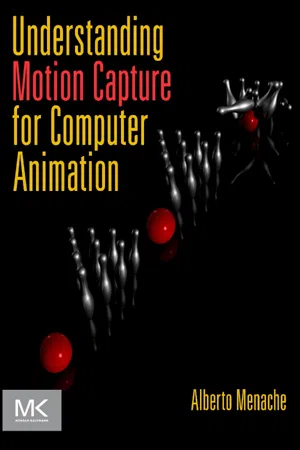The Rotoscope
Motion capture in the entertainment field is the descendant of rotoscoping, a technique still used by some traditional animation studios to copy realistic motion from film footage onto cartoon characters.
The rotoscope device was invented and patented by cartoonist Max Fleischer in 1915, with the intent of automating the production of cartoon films. The device projected live-action film, a frame at a time, onto a light table, allowing cartoonists to trace the frame's image onto paper. The first cartoon character ever to be rotoscoped was Koko the Clown. Fleischer's brother, Dave, acted out Koko's movements in a clown suit. Fleischer wanted to use Koko to convince the big studios to use the new process for their cartoon projects. The sale was difficult because it had taken Fleischer about a year to produce the initial 1-min cartoon using the technique, so he couldn't market it as a mass production tool. Eventually, Fleischer realized that rotoscoping would be a viable technique only for certain shots that required realistic motion.
Walt Disney Studios used some rotoscoping in 1937 to create the motion of human characters in Snow White. Snow White herself and the Prince were partially rotoscoped. The decision to use rotoscoping wasn't a matter of cost, but of realistic human motion. In fact, Snow White went tremendously over budget due to the complexity of the animation.
Rotoscoping has been adopted over the years by many cartoon studios, but few actually admit using it because many people in the animation industry consider it cheating and a desecration of the art of animation.
A two-dimensional (2D) approach, rotoscoping was designed for traditional, hand-drawn cartoons. The advent of 3D animation brought about the birth of a new, 3D way of rotoscoping. Hence, motion capture.
Brilliance
Some of the current motion capture technologies have been around for decades, being used in different applications for medical and military purposes. Motion capture in computer graphics was first used in the late 1970s and early 1980s in the form of research projects at schools such as Simon Fraser University, Massachusetts Institute of Technology, and New York Institute of Technology, but it was used in actual production only in the mid-1980s.
In late 1984, Robert Abel appeared on a talk show and was asked if he would soon be able to counterfeit people digitally. “We are a long ways from that,” he replied. “We haven't even figured out human motion, which is the basis, and that's a year away.” A week and a half later, Abel received a visit on a Friday afternoon from a creative director from Ketchum, a prominent advertising agency. The visitor brought six drawings of a very sexy woman made out of chrome. She was to have Kathleen Turner's voice and would be the spokesperson for the National Canned Food Information Council, an association formed by Heinz, Del Monte, Campbell's, and a number of big players that sold canned food. They felt they had to make a powerful statement because the idea of buying food in cans was becoming obsolete, so they wanted to do something really different and outrageous, and they wanted it to air during the Super Bowl in January 1985. “Can you do it?” asked the client. “You're certainly here a lot earlier than I would have planned,” replied Abel, and asked the client to wait until the end of the weekend for an answer.
At that time most computer graphics consisted of moving logos, landscapes, and other hard objects, and Robert Abel and Associates had already become a player in that market, along with MAGI, Triple-I (Information International, Inc.), John Whitney's Digital Productions, and PDI, all of which had their own proprietary software, because at that time there was almost no off-the-shelf animation software and whatever was available was still in its infancy. Abel's software was initially based on bits and pieces from Bell Labs, Evans and Sutherland, JPL, and other places, and was augmented over time by his group.
The next step would be to animate a digital character. “For storytelling, which was really our goal, we had to have human characters,” recalled Abel, “because nobody better than a human character is able to convey emotion and story. We come from a long line of storytellers that go back maybe 35,000 years, and although the forms may change from cave paintings to digitally made motion pictures, it's still the same thing, it's the passing on of stories.” Creating the first animated digital character would open a Pandora's Box of many new challenges, such as creating realistic skin, hair, and expression. But first they had to deal with the motion.
Abel and his team decided to lock the doors and not leave the building until Monday morning. If by then they didn't have the solution figured out, they would have to pass on the project. Robert Abel and Associates' background in shooting miniatures with motion control cameras since the late 1960s and early 1970s was the key to the solution. They knew that the answer to their problem would have to do with motion and control, except this time it would be human motion. Keyframe character animation was not an option at the time, so they decided to find a way to track the motions of a woman acting the part of the character. It made sense to shoot the woman with several cameras from different points of view, and then use this footage to create a motion algorithm.
Seven people worked throughout the weekend. “Several of us got into our underwear,” recalled Abel. “We got black adhesive dots and we put them on our bodies and we would photog...
